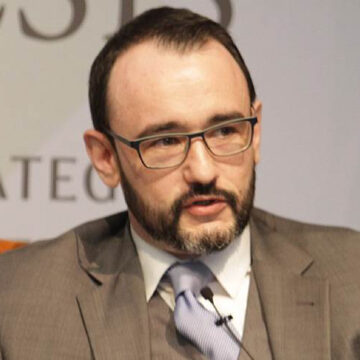The war in Syria has ground on for more than half a decade. Hundreds of thousands have died, entire cities and towns have been destroyed, and billions of dollars in infrastructure have been decimated. Millions of refugees have flooded into neighboring Middle Eastern states that can ill afford to house them, while others have sought safety as far away as Europe and North America, exacerbating divisive battles over immigration, jobs, and cultural identity in Western democracies.
Syria has tested every world leader individually and collectively, and has laid bare the failure of international institutions to deal effectively with the problems those institutions were designed to manage and prevent. Despite a prolonged commitment of U.S. military and diplomatic resources to the conflict, a peaceful settlement remains remote, and the bloody-handed Assad regime remains firmly in control of population centers along the Mediterranean coast. The impending battlefield defeat of the Islamic State (IS) in the desert interior of Syria and Iraq is qualified by the fact that its fighters have joined and inspired more elusive terror cells outside the region.
Meanwhile, the Russian-led coalition, including Syrian forces, Iran, and numerous allied militias, appears to be closing in on its own military and political objectives. The Syrian conflict will likely enter a new phase in 2018, as both IS and the Syrian opposition cease to be relevant forces, and the two coalitions seek to negotiate a postconflict settlement. While it is far from assured that any settlement acceptable to the principle domestic and international players can be struck, for now the main outcome of this war is that President Bashar al-Assad will stay, but the Syria that existed before the war is gone.

Russia has only been directly involved in this conflict since September 2015, but its intervention has radically changed the war’s outcome. The natural question is whether Russia has, in fact, won a victory. The answer to that question depends first on what Moscow intended to achieve—in other words, how did and does Russia define victory in Syria, what are its continuing interests there, and have those interests been secured or advanced?
While the Russian campaign might be judged a qualified success from the standpoint of the Kremlin’s own objectives, Russia’s actual performance in both military and political terms bears closer examination. How did the Russians achieve their successes, both on the battlefield and on the wider diplomatic and political stage? Finally, armed with a better awareness of how Russia’s Syria campaign measured up in terms of Russian objectives and capabilities, what lessons should Americans take away for future U.S. engagement in Syria, the Middle East, and beyond?
Origins of the Russian Intervention
That American and Russian military power came to meet on the ground and in the skies over Syria in 2015 is a kind of historical accident. The country was hardly the centerpiece of either state’s global strategy, or even their respective regional policies.
Russian-Syrian relations draw on a Cold War legacy, since Moscow first began to support Syria after the 1956 Suez Crisis. However, Syria did not become a true client state of the Soviet Union until 1971. The Soviet Union gained a well-situated naval base in Tartus, on Syria’s Mediterranean coast, to support its Fifth Eskadra—an operational naval squadron—along with intelligence-gathering facilities ashore.
Following the collapse of the Soviet Union in 1991, Soviet fleets departed the Mediterranean, and the importance of Syrian bases rapidly declined. Moscow had far less cash available to sustain its patronage network of client states; relations with Syria became decidedly transactional, as Russia sought payment for continued arms sales. Russian ships continued exploiting the port of Tartus as a minor resupply point, but with little military significance. Tartus was, in any case, ill equipped for Russian ships to dock, and for a lengthy period, there was little Russian naval activity to even merit its use. That changed in the wake of the 2015 Russian intervention. The expanded Tartus port is now much more capable of supporting operations and resupplying the Russian Mediterranean squadron, which was stood up in 2013 for the purpose of supporting Syria.
In general, Russia did not seek bases in Syria; it had to establish them and expand existing infrastructure to save the Syrian regime. Buoyed by perceived success, and looking to stay, in 2017 Russia signed a forty-nine-year lease on Tartus, which is still in the process of being upgraded into a serviceable naval base. What the Syrian relationship truly offered for post-Soviet Russia was a position in the Middle East, which helped confer great power status in international politics. A confluence of events led to what would become Moscow’s most significant military foray beyond the immediate post-Soviet space in over a quarter century.

Although Russia had lingering interests in Syria, the changing context of U.S.-Russia relations beginning in 2011 was a more influential factor in how Moscow would come to view this conflict. Russia’s response to the U.S.-led intervention in Libya in that year was categorically negative, and Moscow sought to draw a line in the sand in Syria, opposing U.S. use of force to advance what it viewed as a “regime change” agenda. Foreign Minister Sergei Lavrov applied the Libya logic to Syria directly in May 2011, when he said, “The calculation is that foreign players will get imbued with this problem and will not only condemn the violence there, but subsequently repeat the Libyan scenario, including the use of force.”1
The cornerstone of Russian policy in Syria became preventing the United States from carrying out a Libya-like intervention to overthrow Assad. Lavrov warned, “Some leaders of the coalition forces, and later the NATO secretary-general, called the Libyan operation a ‘model’ for the future. As for Russia, we will not allow anything like this to happen again in the future.”2 The fear of yet another U.S. military intervention, this time much closer to Russia itself, and targeting its only remaining client in the Middle East, was seemingly vindicated when President Barack Obama called for Assad to step aside.3 Russia was determined to check U.S. interventionism, initially by supplying the Syrian regime with arms and equipment, and by blocking efforts to pressure the regime in the UN Security Council.
Equally important was the firm belief among Russian elites that Assad’s downfall would result in IS and al-Qaida affiliates taking over the country, spelling disaster for the region and creating a potential superhighway for Sunni extremists into Turkey and the Caucasus. This concern was somewhat vindicated as the ongoing civil war combined with the displacement of civilians due to the rise of IS resulted in a massive refugee flow into Turkey, neighboring countries, and central Europe, causing uncertainty and threatening regional stability (see figure 1). Unlike distant Libya, a complete implosion of Syria was not only too close for Russia’s comfort, but thousands of Russian citizens and thousands more Russian-speakers from the wider region had already joined militant extremist groups fighting there.4 Moscow feared that in the event of an IS victory, some of those fighters would enter Russia and join insurgencies in the North Caucasus or plot attacks against the Russian heartland. Accordingly, some Russians described entering the fray in Syria as launching a preventive war against terrorism.
Russian interests and objectives in the Syrian intervention also stem from the collapse in Russia-West ties following Moscow’s invasion of eastern Ukraine and annexation of Crimea in 2014. In this sense, U.S. and European sanctions and diplomatic pressure catalyzed the Russian decision to intervene in Syria. Rather than giving in to Western pressure and offering concessions on Ukraine, Moscow looked to Syria to broaden the confrontation on terms more favorable to itself. Eventually, Russia hoped its Syrian intervention could force Washington and its European allies to abandon Ukraine-related sanctions and diplomatic isolation in the interests of achieving a negotiated settlement with Russia over Syria.
Russian domestic political considerations were also a factor, though their role should not be overstated. Russia’s military dealt Ukraine a blow at the battle of Debaltseve in February 2015, leading to the second Minsk ceasefire agreement, which appeared to be a political victory for Moscow. The agreement quickly broke down, however, and Western sanctions remained in full effect, taxing the Russian economy at a time of persistently low energy prices. Struggling to stabilize the economic situation at home, and with policy in Ukraine increasingly adrift, there was little prospect for Russian leadership to gain further victories either at home or in Russia’s near abroad. Although Moscow hardly saw entering a bloody civil war in the Middle East as a path to easy gains, Russia’s tolerance for the risks attendant on intervention grew dramatically in the face of these domestic and international pressures.
A limited Syrian intervention, calibrated to reduce political risk at home, became the less perilous proposition. By mid-2015, Moscow had few alternatives to use of force if it hoped to shore up the Assad regime, its ally in Damascus. In April, the situation for Assad’s forces was dire. Al-Qaida’s affiliate in Syria, Jabhat al-Nusra, had assembled a coalition of fighters into the “Army of Conquest,” which drove back regime forces in the northwest and threatened major population centers further south. At the same time, IS was pushing westward, and had captured the historic city of Palmyra. Assad’s forces were being squeezed, and they were falling back on almost all fronts. That summer, the head of Iran’s Quds Force, Qassem Soleimani, together with senior Syrian officials, made several trips to Moscow in an effort to coordinate a military intervention.5 By August that year, there were clear indicators that Russia was preparing to intervene, and when Russian tactical aviation began arriving at Hmeimim Air Base in September 2015, the die was cast. Figure 2 depicts the approximate Syrian situation in terms of territorial control exercised by participants in the conflict near the outset of Russian operations initiated in support of the Assad regime.
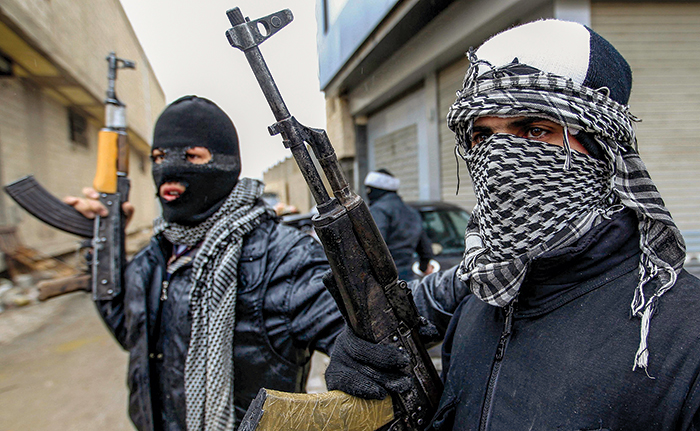
Framing the Russian Intervention
Although hemmed in by tactical necessities, Moscow’s entry into the Syrian fray was also strategically ambitious. A successful intervention could offer victory on three fronts: preventing U.S.-backed regime change in Syria, breaking out of political isolation and forcing Washington to deal with Russia as an equal, and demonstrating at home that Russia is a great power on the main stage of international politics. Moscow hoped Syria would offer a new and more favorable front, where the United States could be outmaneuvered in the broader confrontation, which up to 2015 centered almost entirely on Russian actions in Ukraine.
Once military operations began, as is often the case with military campaigns, the intervention would take on additional objectives, reflecting secondary or tertiary vested interests. “Ambition creep” is a common illness afflicting most great powers when they deploy military forces. Russia may not have come to Syria with hopes of regaining power and status in the Middle East at the top of its agenda, but regional aspirations grew with each success on the battlefield. As a consequence, Russia has become a potential powerbroker, and perhaps a balancer against U.S. influence, even if it did not embark on the Syrian campaign with those goals in mind.
Whatever Russian expectations of success may have been—and there are indications that the Syrian leadership misled Moscow early on as to the true state of its forces (historically not an uncommon practice for Damascus)—Moscow pursued a campaign with both political and military objectives in fairly close alignment. These efforts were mutually reinforcing, but a path to victory had to overcome steep challenges.
On the ground, Russian forces had to find a way to quickly and dramatically alter the balance in Assad’s favor by destroying the opposition’s capacity to continue the fight, while working under severe resource constraints. In parallel, Russia had to change the calculus and policy of its principal opponents in this conflict, including Turkey, the United States, and Saudi Arabia, while entering into arrangements with other potential actors in the region. Otherwise, military gains would quickly disappear in the sand, and a political victory would be elusive. Russia also needed a political process running concurrently to lock in military gains on the ground, since as Mao Zedong wrote, political power would “grow from the barrel of a gun.”
Relations with allies like Iran, cobelligerents in the form of local militias, or potential spoilers such as Israel had to be carefully managed. The compound risk of conflicting political incentives and operational objectives among these parties made for a complex battle space. The risks of escalation to direct conflict between the intervening powers were considerable, as underscored by Syria’s use of chemical weapons in March 2017, resulting in a prompt retaliatory U.S. cruise missile strike, or the Turkish shoot down of a Russian Su-24M2 in November 2016. Russia led the coalition, but never controlled it; thus, it had to be comfortable with uncertainty and the associated risk of having the likes of Syria, Iran, and Hezbollah on its team.
Success for Russia entailed securing a commitment from the other parties to pursue a political settlement largely on its terms. This meant convincing Saudi Arabia and Turkey that their respective proxies had no chance of victory in the war, and pushing the United States to abandon its policy favoring regime change. Over time, Moscow achieved success on both the military and political fronts, coercing adversaries and negotiating changes to their positions one by one, though the pathway to this outcome was hardly a smooth or straightforward one. Russia’s success is not unqualified, but at the time of this writing, it appears that if the campaign in Syria is not a victory for Russia, it is certainly a defeat for those who opposed the Russian-led coalition.
Russian Strategy in Syria
To achieve this success, Russia had to secure some leverage in Syria, which in turn rested on being able to destroy the Syrian opposition and compel opponents to change their policies, forcing them and their proxies in the conflict to the negotiating table on terms favorable to Russia’s coalition. Moscow also sought the opportunity to reframe itself as a positive force in the battle against terrorism, and press the United States into military cooperation. Russian leaders hoped this would ultimately fracture Western cohesion on punitive measures imposed over Ukraine, and grant Russian President Vladimir Putin recognition as a prominent player in international affairs.
These were the desired ends, yet the Russian strategy was not deliberate. If anything, Russia pursued an “emergent,” or “lean,” strategy. This was an approach characterized by the “fail fast, fail cheap” ethos of startup business, with iterative adjustments to the operation. The centerpiece of this strategy was flexibility, with a preference for adaptation over more structured strategy. In emergent strategy, success begets success, while failure is never final or disqualifying. Several vectors are pursued simultaneously, and at times, they may even appear to be contradictory. Resources are added in favor of the approach that shows the most progress, while others are discarded without regard to “sunk costs.”6
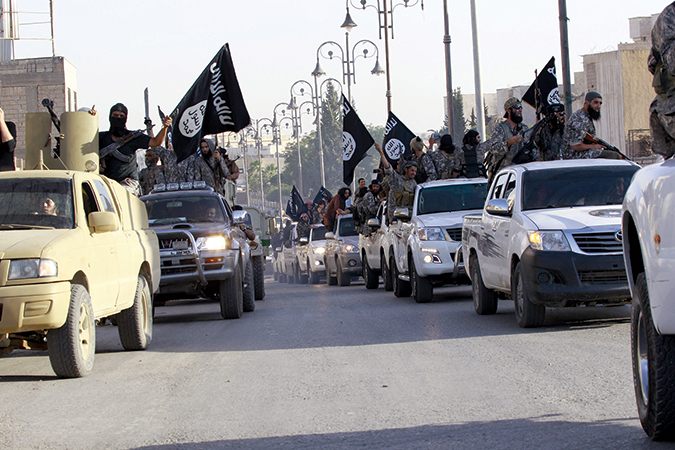
To be successful in implementing a lean strategy, leadership must be agile, politically unconstrained, and uncommitted to any particular approach in the battle space (i.e., willing to improvise and adjust course). In Russia’s case, it actually helped being an authoritarian system, and having relatively few allies or other geopolitical constraints on decision-making. But Russia also had few other options. Given resource constraints and high uncertainty, including poor information about the reality on the ground from its allies, Russia was not in a position to pursue a more deliberate strategy. That limitation ultimately played to Russia’s advantage relative to other powers, which expended considerably more blood and treasure via structured and deliberate, but ultimately less successful approaches in the region. Russia’s lean strategy worked, because when flawed assumptions were proven wrong in the conflict, it could quickly pivot and adapt.
Still, the limitations of the Russian armed forces imposed hard constraints on Russia’s overall operation. The Russian military had almost no experience with expeditionary operations after withdrawing from Afghanistan in 1989, Syria itself had limited capacity to host a major military footprint, Russia’s long-range supply and support capabilities were weak, and the Russian military was in the midst of major reforms and modernization. Coordinating with Iran and its associated Shia militias like Hezbollah was an added complexity on an already crowded battlefield, while Russian commanders had a generally low opinion of Syrian forces’ combat performance. In short, it was far from clear how the forces Russia could deploy would make the impact needed to turn the conflict around. Early on, outside observers doubted the prospects for Russia’s intervention, especially given recent Western experiences in expeditionary operations in the Middle East.
The campaign Russia envisioned would be based on a small footprint to keep its exposure low, reducing the chances of being steadily dragged into a conflict where local actors increasingly gain leverage over a stronger international benefactor. Russian leadership instead sought room to maneuver, retaining flexibility and the option of quick withdrawal should things go badly. In the early days of Russia’s intervention, physical constraints limited its presence. Tartus was not a real naval base, Hmeimim Air Base lacked apron space for a large contingent of Russian aircraft, other Syrian bases were exposed, surrounded, or ill equipped, and Russian logistical support would have limited throughput.
In short, reality helped dictate a more conservative and ultimately smarter approach to the battle space. It was not Moscow’s skill or experience, but the absence of abundance and limited options that made the Russian armed forces savvier in how they approached the conflict. That said, even after expanding the Syrian air base and making major investments in the naval facility, Russia’s General Staff continued to calibrate presence down to the bare minimum necessary. By 2017, it became clear that despite increased local capacity to host Russian forces, and improved infrastructure, Moscow was reluctant to use it. The opportunity to expand the means applied to this conflict was there, but Russia did not want it, judging that Syria would not be won with a means-based approach, the all too familiar “more is more” school of thought.
The Russian strategy was about Syrian, Iranian, and Shia militias doing the fighting and Russian forces providing support, not the other way around. Syria continued to reveal the general Russian preference to use local forces first, mercenaries and other Russian proxies second, and its own forces last, only for decisive effect on the battlefield. Russian military power would pulse, peaking when necessary in support of offensives and withdrawing when judged unneeded.
Russian Combat Operations in Syria
When Russian forces first arrived in Syria in September 2015, they inherently introduced a new dynamic, compelling what became a dialogue on “deconfliction” arrangements with the United States. Several Su-30SM heavy multirole fighters were shown on the runway at Hmeimim Air Base as Su-24M2 bombers began to deploy. Leveraging an upcoming UN Security Council General Assembly summit, Moscow pressed for a high-level bilateral meeting between Putin and Obama—a break from what had been more than a year of U.S.-imposed diplomatic “isolation” of Russia in the wake of Russia’s annexation of Crimea.
Though the Obama administration rankled at the appearance that it had been coerced into restoring military dialogue, the risk of a military incident between the two big nuclear powers in the skies over Syria trumped other considerations.7 In a ninety-minute discussion, the two sides agreed to continue efforts to “deconflict” operations. Within days, Russia had achieved its first political gains from the intervention, which had yet to conduct a single sortie.
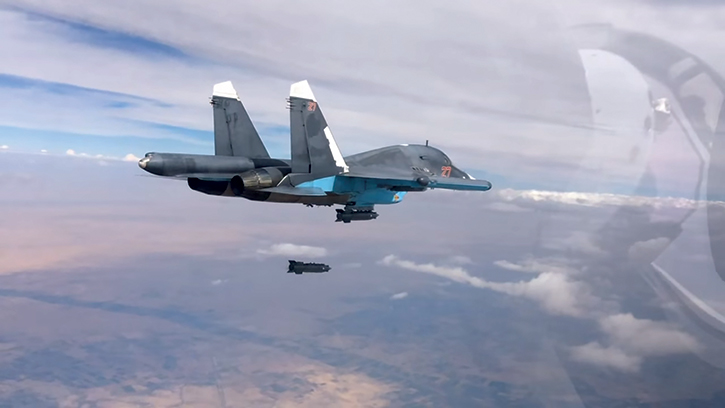
Still, it was clear that there was no agreement on the political way forward in Syria, and early Russian targeting in the air campaign, which launched on 30 September 2015, revealed that Russia’s air wing would focus on the “moderate” Syrian opposition under the rubric of a counterterrorism fight. Moscow’s rules of engagement were relatively simple: there was little to no distinction between the various nongovernment armed groups in Syria, as all except for Kurds and pro-regime militias would be considered “terrorists.” Putin declared at the UN assembly, “We think it is an enormous mistake to refuse to cooperate with the Syrian government and its armed forces, who are valiantly fighting terrorism face to face. We should finally acknowledge that no one but President Assad’s armed forces and Kurdish militias are truly fighting the Islamic State and other terrorist organizations in Syria.”8
This was not just a matter of convenience for the sake of establishing a free-fire zone. Indeed, from Russia’s perspective, there was no such thing as a “moderate” opposition in Syria, and the entire term was a misguided Western invention aimed at legitimizing extremists opposed to Assad. The Russian political strategy at home and abroad was to frame the conflict as binary—only Assad’s regime had legitimacy, and all others were de facto terrorist groups of varying stripes allied with IS or Jabhat al-Nusra.9 Over time, Russia would also seek to create a systemic opposition, cobbling together forces that would be amenable to sharing power with the Assad regime.
Taking advantage of the momentum in 2015, Russia set up an intelligence sharing and coordination center in Baghdad, which included Syria, Iran, Iraq, and Israel. The center’s purpose was to deconflict Russian air operations with neighboring countries. Moscow also hoped to create the public sense that it was leading a coalition of countries in a counterterrorism effort no less legitimate than the U.S.-led coalition against IS. Russia’s leadership sought to parlay this posture and the U.S.-Russian deconfliction dialogue into more formal recognition of U.S.-Russia cooperation in Syria. Indeed, Moscow repeatedly asked for Washington’s acknowledgment of the Russian-led coalition as a legitimate partner in the Syrian war, which would have amounted to a recognition of Russia as Washington’s geopolitical “equal,” at least in this context.
Initial Russian combat operations were intended to change the momentum on the battlefield, providing a substantial morale boost to the Syrian forces and allied militias. Russia also hoped the United States would cede the battle space, at least by default, by focusing on its own combat operations against IS in Northern Iraq, and Kurdish allies in Syria. This would mean a rapid abandonment of the moderate opposition and other proxies seeking Assad’s overthrow, who would be powerless to deal with Russian airpower and increasingly isolated on the battlefield. In many respects, this goal was accomplished, as Russia and the United States established a de facto division of labor in Syria and complementary campaigns.
The first Russian deployment to Syria consisted of thirty-three aircraft and seventeen helicopters. These included twelve Su-24M2 bombers, twelve Su-25SM/UB attack aircraft, four Su-34 fighter-bombers, four Su-30SM heavy multirole fighters, and one Il-20M1 reconnaissance plane. The helicopter contingent consisted of twelve Mi-24P attack helicopters and five Mi-8AMTSh transports.10 Later in 2015, this number would grow with four more Su-34 fighter-bombers and four additional Su-35S air superiority fighters. Mi-35M attack helicopters and Mi-8 transports arrived in the following months. A Mediterranean squadron led by the Black Sea Fleet would support the operations from the sea, though the Russian navy mostly concerned itself with providing logistical supplies to the intervention via landing ship tanks in what was dubbed the “Syrian Express.” In order to supplement limited transport capacity at sea, and equipment brought in by air via Ruslan An-124 cargo planes, Russia purchased eight Turkish cargo vessels and pressed four of them into service.
Initial Russian objectives focused on regaining access to key roads, linking infrastructure, breaking isolated Syrian bases out of encirclement, and softening up opposing forces by destroying as much hardware as possible—much of it captured earlier from the Syrian army. Although in the early months Russia had supposedly only helped Syria regain control of 2 percent of its territory, by February 2016, it was clear the air campaign was having an effect in shaping the battlefield, and with it, the political fortunes of the Syrian opposition. The opposition’s momentum stunted, Syrian morale began to recover.
Territorial control in Syria was always elusive, as local leaders would sign up with whoever was winning. Thus, “control” could swing rapidly toward the side that had the clear momentum, and Russian forces oversaw numerous “ceasefire agreements” between Syrian forces and village leaders. In reality, Assad’s forces had control over much of the population of Syria, while large tracts of opposition or extremist held territory were depopulated from the fighting. Thus, it would take less than two years for the Russian-led coalition to make the leap from gaining only 2 percent of territory to appearing to be the victor in the conflict.
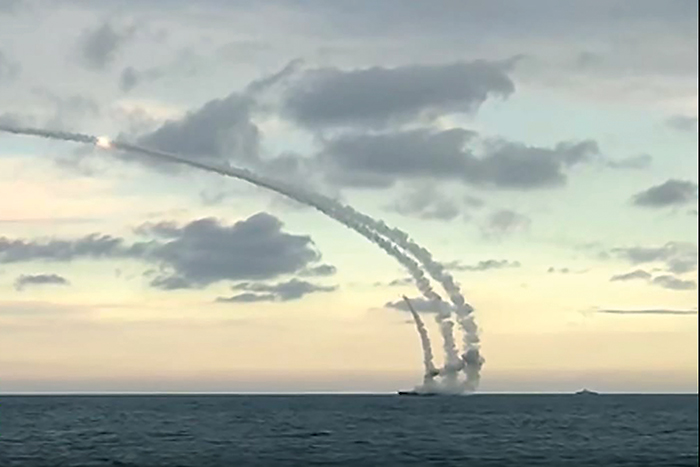
Russian aircrews flew sorties at a high rate, averaging perhaps forty to fifty per day, but spiking to one hundred during peak combat times, such as January 2016. Two crews per airframe were needed to sustain the intensity of operations, along with a small village of defense contractors to support the newer platforms being fielded in Syria. Russian airpower in Syria never exceeded thirty-to-fifty combat aircraft and sixteen-to-forty helicopters of various types, a deployment many times smaller than the combat aviation group the Soviet Union fielded in Afghanistan.11 The rate of mechanical failure or combat loss was also magnitudes less than previous Russian or Soviet air operations.
During the conflict, Russian aerospace forces would be supported by around 3,000 ground troops, with perhaps 1,500 based at Hmeimim alone. These would include Naval Infantry from the 810th Brigade based in Crimea, elements from the 7th Airborne Assault Division, armored companies fielding T-90A tanks, MSTA-B towed artillery, and a host of air defense units including Buk-M2, Pantsir-S1 and S-400 units. Sophisticated electronic warfare equipment was deployed as well, alongside Russia’s Special Operations Command. After the capture of Palmyra in the spring and of Aleppo in the fall of 2016, Russia also introduced demining units and specialized military police units from the North Caucasus.
Russia’s special operations command featured prominently throughout the conflict, conducting diversionary operations, targeted killings, and reconnaissance. Another two thousand or so private military contractors (PMCs), the largest of which is known as Wagner Group, bolstered Syrian forces and absorbed most of the casualties on the battlefield. With Russian air power in support, veterans-turned-PMCs made a difference amidst the poorly trained militias, taking the risk for $4,000–$5,000 per month.
On the whole, Moscow sought to keep its presence small. The initial force did not field long-range air defenses or dedicated air superiority fighters; rather, their arrival was prompted by an unexpected incident with Turkey, when Russia’s Su-24M2 was shot down by a Turkish F-16 in November of 2015. The Russian bomber had been attacking Turkmen militias in Syria, and had strayed through Turkish airspace. Indeed, Russia’s air force repeatedly violated Turkish airspace in an effort to coerce Turkey to change its policy in Syria and reach a modus vivendi with the Russian-led coalition. The crisis between Russia and Turkey was arguably the most dangerous moment of the entire intervention, and likely the closest a NATO country had been to military conflict with Russia in decades.
The Russian reaction to the incident was to impose harsh economic and political sanctions on Turkey, while showing on the battlefield that Turkish-backed forces had little hope of achieving victory over Assad. By the summer of 2016, Ankara gave in, issuing a quasi-apology in order to restore normal relations with Moscow. One by one, Russia would seek to change the positions of the major parties backing anti-Assad forces in Syria. First, Moscow pushed Washington to concede that a policy of regime change was not only unrealistic, but that its support for the Syrian opposition had no chance of success, all the while dangling the prospect of a ceasefire and humanitarian relief for civilians in the conflict. The United States did inch toward tacit acceptance of the Russian intervention, and of Assad’s de facto victory over the radicals as well as the U.S.-backed opposition.
Russian ambitions were also well served by competition among U.S. allies in the region, who frequently and vocally disagreed with Washington’s approach. Turkey was more hostile toward Kurdish fighters in Syria than toward Assad or IS, yet the Kurds were Washington’s chief ally against IS on the ground. Washington also had no interest in supporting Sunni extremist groups favored by the Saudis and other Arab states, nor were extremists seen as a viable alternative to the bloody Syrian regime. Eventually, after crushing Turkish-backed proxies in Syria, Russia got the cooperation it sought with Ankara. Saudi Arabia, too, began to show flexibility, and in October 2017, the Saudi king visited Russia for the first time in recognition of Moscow’s growing significance in the Middle East.
Russia also saw Syria as a testing ground for new weapons and platforms, giving as much of its military an opportunity to participate in the conflict as possible. This included rotating countless crews through the theater of operations, giving ships and bombers the opportunity to fire cruise missiles, and fielding a small ground force as well. After a period of military reforms from 2008 to 2012 and a large modernization program begun in 2011, Moscow wanted to bloody its air force in conflict.
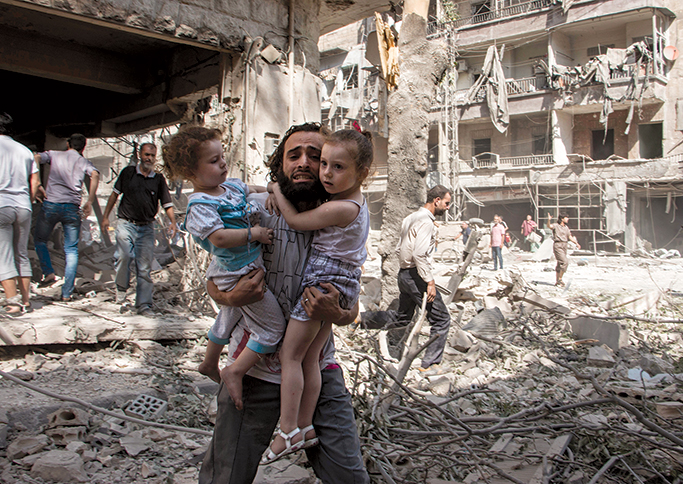
Syria has had a profound impact on the Russian armed forces, as countless officers have been rotated through the campaign on three month stints to gain combat experience. According to Russia’s Chief of General Staff Valery Gerasimov, the commanders of military districts, combined arms armies, air force and air defense armies along with many of the divisional commanders have gained experience in Syria.12 Promotions in 2017 further advanced those who served in Syria. The experience will shape Russian military thinking and personnel decisions for years to come.
Alongside these training objectives, Russia also used combat operations in Syria as a technology demonstration for arms sales abroad, showing off the latest generation of Russian tech alongside older Soviet workhorses that did most of the fighting.
Starting with an initial strike on 7 October 2015, over the course of the conflict, Russian ships and submarines fired numerous Kalibr land-attack cruise missiles from the Caspian Sea and Eastern Mediterranean. Similarly, Russia’s long-range aviation joined the fray in November 2015, and since then, Tu-95MS and Tu-160 strategic bombers have flown a substantial number of sorties deploying Kh-555 and newer Kh-101 air launched cruise missiles against targets in Syria.13 The Tu-22M3 medium bomber force supplemented combat sorties from Hmeimim Air Base, though these aircraft exclusively dropped FAB unguided bombs from medium to high altitude. Later Moscow would also field Iskander-M short-range ballistic missile systems, Bastion-P antiship missiles, and other advanced weapons in an effort to demonstrate their capability.
Although the precision-guided weapons involved in the conflict represented a tiny portion of the actual mixture of weapons used, perhaps less than 5 percent, Russia demonstrated the capacity to employ long-range guided weapons from various platforms. Syria showcased both the advances Russian airpower forces had made since their dismal performance in the Russia–Georgia War of 2008 as well as the remaining limitations of Russia’s armed forces. Much of the bombing was done by older Su-24M2 and Su-25SM aircraft, and almost all of it with unguided area-of-effect munitions. With the exception of systems on the Su-34, which was used to employ the KAB-500S satellite-guided bomb, among other precision weapons, Russian fixed-wing aircraft as a whole lacked targeting pods to effectively employ precision-guided munitions.14
Russian naval aviation was not impressive. The carrier strike-group sortie to Syria ferried by Russia’s vintage Kuznetsov heavy-aviation-carrying cruiser in 2016 was a publicity disaster, losing a Su-33 and Mig-29K to equipment failures. Otherwise, remarkably few Russian aircraft were lost, with most of the casualties among helicopter crews. Russian technicians kept both old- and newer-generation aircraft in the sky, with only one Su-24M2 lost to technical failure.
Russian air strikes were certainly effective, but incredibly costly in civilian casualties and collateral damage inflicted, some of which appeared intentional. Much of the ordnance used was for area of effect, and much too large in payload for targets in Syria. The Russian Aerospace Forces as a whole are still confined to an early 1990s form of fighting (though still a generational leap from where they were in 2008), but relying almost entirely on unguided weapons and, more importantly, lacking in the ISR assets necessary to conduct information-driven combat operations. Russia’s Aerospace Forces also lack the means to engage small moving targets with guided precision, relying on unguided weapons and munitions that are truly overkill.15 Just as the Soviet Union before it, the Russian military is a brutal mauler in close quarters, but continues to struggle in finding and seeing its target.
Russia made heavy use of drones to supplement its manned air campaign, conducting battle damage assessment and reconnaissance. Russian drones are rumored to have flown more sorties than manned aviation over Syria. The best Russian drones were licensed production variants of Israeli models—a product of Russian-Israeli defense cooperation. Despite substantial spending on development, Russia still has no armed unmanned aircraft systems, and thus lacks a real time recon-strike option for its drone platforms. Syria highlighted the need for Russian armed forces to invest further in the development of unmanned strike systems, and develop a larger repertoire of guided weapons for the Aerospace Forces, particularly for tactical employment.
Those limitations aside, Moscow did use the Syrian campaign effectively as part of a broader diplomatic and political engagement with the United States, demonstrating capability and resolve to use long-range guided weapons, many of which have nuclear-tipped variants. Syria did much for Russian coercive credibility, painting a clear picture about the resurgent capability and capacity of its armed forces to impose costs on NATO in a conventional conflict and its ability to reach out at long ranges to hold much of Europe at risk, if need be. Long-range strikes by strategic bombers, ships, and submarines should not be viewed simply as combat tests to gain experience; they were also intended as strategic messaging to boost Russian credibility writ large.
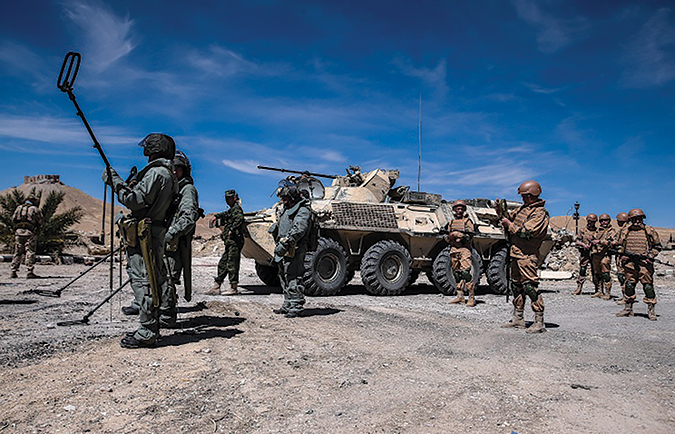
Not Home by Christmas
Upon entering the conflict, Russian armed forces quickly discovered that the intervention would take considerably more time than initially expected or desired. Syria’s army had degenerated into armed militias that were formally unified under the Assad banner but that no longer represented a coherent fighting force. Russian leadership was aghast at the large amount of Syrian and Iraqi hardware captured by the opposition and various militant groups while the Assad regime held barely 10 percent of territory. Some Syrian units were still capable of action, but Russian officers would have to embed across these units to conduct military operations and start rebuilding the Syrian army’s fighting potential.
Despite an influx of Iranian and Hezbollah troops in October 2015, it was clear that the warring sides were all leveraging proxies on a battlefield with a low density of forces. Their combat effectiveness was poor, and Syrian forces would continually call in Russian air strikes, make small gains, and retreat at the first sight of counteroffensives by well-motivated Jabhat al-Nusra or other fighting groups.
Over time Russia would train up lower ranking Syrian officers, and establish the 5th Volunteer Assault Corps, led by Russian commanders and equipped with more advanced Russian equipment. The 5th has been Syria’s primary assault force for the past year. Combining Syrian fighters, PMCs, and Russian leadership to put together offenses has yielded battlefield victories at minimal cost.
Russian operational objectives were suited to its strategy: make decisive gains where possible, fragment the Syrian opposition, and seek to parlay victories in Syria into broader political objectives with the United States. To this end, the Russian General Staff sought to avoid exhaustive battles over population centers, especially given that Syrian forces lacked the manpower to hold anything they took. Such an approach would, and eventually did, result in having to retake the same terrain multiple times, as in the case of Palmyra. Russia also genuinely wanted to turn the fight eastward toward IS in an effort to glue together its effort at cooperation with the United States. Syria and Iran were not interested, instead seeking near total victory over the opposition and the recapture of all the major population centers in the west.
While Russia retained the image of a powerbroker and leader of the coalition, in reality, it did not have buy-in for such a strategy from its allies and cobelligerents; nor could Moscow compel them. In this regard, Russia suffered from the same deficit as the United States. Both were outside powers intervening in Syria without the necessary influence over local and regional allies to broker big deals. These differences came to the fore in March 2016, when Russia declared its withdrawal from Syria while turning the attention of its forces to Palmyra. In fact, Moscow had no intention of withdrawing, simply deleveraging and settling in for a longer fight, while Assad was focused on retaking Aleppo.
With its March declaration, Russia sought to recast the intervention in Syria as a sustainable longer-term security presence in support of a political settlement, rather than combat per se. The idea was to normalize Russian operations in the eyes of Russia’s domestic audience and to declare victory in some form. Medals were handed out and a small contingent was rotated back home, but meanwhile, Russia prepared to turn the Syrian campaign into smaller “campaigns” to avoid the perception that the intervention could take years. The first segment was concluded with the Russian capture of Palmyra in March 2016. Syrian and Iranian forces then turned toward Aleppo, a battle that ultimately scuttled Russian attempts to negotiate a joint integration group with the United States. The second cut was made in January 2017, after the seizure of Aleppo, and a third “victory” has been set at the closing of 2017 as Syrian forces capture Deir ez-Zor and IS appears on the verge of defeat.
This latest declaration of victory, ahead of the March 2018 presidential election, is fraught with risk since Russian forces are not just staying but further expanding the infrastructure at Tartus and Hmeimim. As Gerasimov said in a recent interview, “we’re not going anywhere.” Not long thereafter, a mortar attack on 31 December damaged several planes and killed a number of Russian soldiers at the airbase. The strike was followed by a drone attack from militant groups against both bases on 6 January. Both were a stark reminder that triumphalism is somewhat premature, and Russian forces in theater remain at risk. Figure 3 depicts the approximate Syrian situation as of November 2017 in terms of territorial control exercised by participants in the conflict near the official close of Russian operations initiated in support of the Assad regime (see figure 1 for a comparison to the situation at the beginning of the campaign).
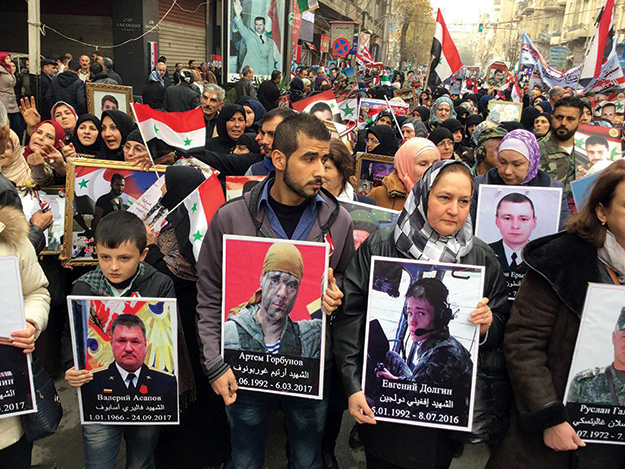
Postconflict Settlement and Beyond
Now that the bulk of Syrian territory and population centers have been wrested from the hands of antiregime opposition groups, Russia can turn its full attention toward the postconflict settlement. It is true that Assad has committed to retake “every inch” of Syrian territory, and that even if Russia does not support this ambition, it will have little choice but to back continued regime efforts to secure energy and water resources in the country’s north and south. However, the main focus of both the Russian military and political action will be around the diplomatic settlement and supportive conditions on the ground.
Most importantly, Russia has apparently gained Washington’s acceptance of its role as a key broker in Syria’s future. In their November summit meeting in Vietnam, Presidents Trump and Putin confirmed not only continuing U.S. and Russian deconfliction dialogue and support for “de-escalation zones,” a largely Russian initiative, but also underscored the centrality of the political process for negotiating a postconflict future for Syria. That process is shaping up in line with Russia’s main strategic interests.
First, Russia has broken the monopoly of the Geneva process and of U.S. diplomatic leadership. It has successfully integrated both the Astana-based negotiations it launched in 2016 to the formal UN-backed international process and has regularly convened meetings of various opposition groups in an attempt to foster the emergence of a common opposition grouping, which will be amenable to compromise with the Assad regime. Moscow’s progress on the political front is fitful, but at this writing it appears to be the only plausible path forward.
Second, Russia has managed to maintain productive ties with each of the other key regional players, ranging from Saudi Arabia on one end of the spectrum to Iran on the other. In fact, despite continuing disagreement with Saudi Arabia over the composition of the “legitimate” Syrian opposition to be represented at Geneva, and with Turkey over the role of the Kurdish self-defense forces, Russian diplomacy (backed by military force) has won recognition from both, a fact that is especially welcome in Moscow in the run-up to Russia’s March 2018 presidential election. Iran has proven a thorny ally for Russia; however, the relationship between the two countries remains largely stable, since the Iranians expect to be able to maintain their de facto dominance on the ground in much of Syria, solidifying their corridor of power from Iraq to Lebanon.

Finally, Russia will retain its ally in Damascus, because for the foreseeable future, the Assad regime appears back in control. In fact, Assad’s stock has risen so much since the Russian intervention two years ago that he is largely able to set the terms of his participation in the Geneva process. The opposition can howl in protest, but the regime has simply refused to engage in negotiations if the question of its own departure is on the agenda.
This is also clearly a victory for Russia, since Moscow has capitalized on its victories to secure long-term leases on its military facilities at Hmeimim and Tartus, as well as to position Russian firms to play potentially prominent and lucrative roles in Syrian reconstruction, especially in the energy and energy transit sectors. Russia not only needs these bases to continue supporting Syrian forces, but the conflict is now also part of a larger bid for becoming a power broker in the Middle East, and a balancing option for those seeking to hedge against U.S. influence.
The main area in which Russia’s Syria campaign fell clearly short of initial objectives was in the effort to broaden the platform for diplomatic engagement with Europe and the United States in the wake of the Ukraine crisis and associated Western sanctions. Although Moscow did break through the Obama administration’s attempted isolation policy by forcing Washington to conduct deconfliction talks, those talks have not expanded into the full-fledged Russia-U.S. cooperation for which the Kremlin had hoped. Moreover, there has been zero willingness from Western capitals to think of Syria and Ukraine in quid pro quo terms. As much as Westerners may lament the death toll and flood of refugees from the Syrian civil war, the Ukraine conflict is simply much closer to home, and European governments have held firm in their support for sanctions tied to fulfillment of the Minsk agreements, while the United States has actually ratcheted sanctions dramatically upward in the wake of Russia’s apparent attempts to meddle in the 2016 U.S. election.
In sum, Russia appears to have won at least a partial victory in Syria, and done so with impressive efficiency, flexibility, and coordination between military and political action. On the one hand, Russia’s embrace of the Assad regime and its Iranian allies, its relative indifference to civilian casualties, and its blanket hostility to antiregime opposition groups are fundamentally at odds with widely held U.S. views on Syria. On the other hand, Russia’s “lean” strategy, adaptable tactics, and coordination of military and diplomatic initiatives offer important lessons for the conduct of any military intervention in as complex and volatile an environment as the Middle East. More than a decade and a half into the U.S. involvement in Iraq and Afghanistan, with ongoing fighting in Libya and Yemen, and countless other tinderboxes that could ignite wider regional conflict threatening U.S. interests, Washington should pay close attention to the Russian intervention and how Moscow achieved its objectives in Syria.
Notes
- Sergei Lavrov and Russian Media, “On Syria and Libya,” Monthly Review (website), 17 May 2011, accessed 15 December 2017, https://mronline.org/2011/05/17/on-syria-and-libya/. The text is an excerpt from “Transcript of Russian Foreign Minister Sergey Lavrov’s Interview to Russian Media Following Attendance at Arctic Council Meeting, Nuuk, May 12, 2011,” published on the Russian Foreign Ministry website on 13 May 2011.
- “Sergey Lavrov’s Remarks and Answers to Media Questions at Joint Press Conference with UAE Foreign Minister Abdullah Al Nahyan,” The Ministry of Foreign Affairs of the Russian Federation (website), 1 November 2011, accessed 10 January 2018, http://www.mid.ru/en/vistupleniya_ministra/-/asset_publisher/MCZ7HQuMdqBY/content/id/186758.
- Macon Phillips, “President Obama: The Future of Syria Must Be Determined by Its People, but President Bashar al-Assad Is Standing in Their Way,” White House Press Office (website), accessed 19 December 2017, https://obamawhitehouse.archives.gov/blog/2011/08/18/president-obama-future-syria-must-be-determined-its-people-president-bashar-al-assad.
- Vladimir Frolov, “Signing In is Easier than Quitting,” Vedomosti (website), 29 September 2016, accessed 19 December 2017, https://www.vedomosti.ru/amp/a00ffd6a64/opinion/articles/2016/09/29/658952-voiti-legche-viiti.
- “Iran Quds Chief Visited Russia despite U.N. Travel Ban: Iran Official,” Reuters, 7 August 2015, accessed 19 December 2017, http://www.reuters.com/article/us-russia-iran-soleimani-idUSKCN0QC1KM20150807; Michael Kofman, “A Tale of Two Campaigns: U.S. and Russian Military Operations in Syria,” Pathways to Peace and Security 1, no. 52 (2017): 163–70.
- Michael Kofman, “The Moscow School of Hard Knocks: Key Pillars of Russian Strategy,” War on the Rocks (website), 17 January 2017, accessed 19 December 2017, https://warontherocks.com/2017/01/the-moscow-school-of-hard-knocks-key-pillars-of-russian-strategy/.
- Teresa Welsh, “Obama, Putin Meet in New York,” U.S. News & World Report (website), 28 September 2015, accessed 19 December 2017, http://www.usnews.com/news/articles/2015/09/28/obama-putin-meet-in-new-york.
- Washington Post Staff, “Read Putin’s U.N. General Assembly speech,” Washington Post (website), 28 September 2015, accessed 19 December 2017, https://www.washingtonpost.com/news/worldviews/wp/2015/09/28/read-putins-u-n-general-assembly-speech/?utm_term=.48d2be2b7823.
- Nikolas K. Gvosdev, “Moscow’s War in the Air: Russia Sends a Message in Syria,” The National Interest (website), 1 October 2015, accessed 19 December 2017, http://nationalinterest.org/feature/moscows-war-the-air-russia-sends-message-syria-13983.
- Ruslan Pukhov, “Russian Military, Diplomatic and Humanitarian Assistance” in Syrian Frontier, ed. M. U. Shepovalenko, 2nd ed. (Moscow: Center for Analysis of Strategies and Technologies, 2016), 105–7, accessed 9 January 2018, http://cast.ru/upload/iblock/686/6864bf9d4485b9cd83cc3614575e646a.pdf.
- Ruslan Pukhov, “The War that Russia Won,” Izvestia (website), 13 October 2017, accessed 10 January 2018, https://iz.ru/652856/ruslan-pukhov/voina-kotoruiu-rossiia-vyigrala.
- Valery Gerasimov, “We Broke the Back of Terrorists,” interview by Victor Baranets, Komsomolskaya Pravda (website), 26 December 2017, accessed 10 January 2018, https://www.kp.ru/daily/26775/3808693/.
- The initial employment of long-range aviation was in response to the terrorist bombing of Russia’s MetroJet flight out of Egypt.
- Pukhov, “The War that Russia Won.”
- Ruslan Pukhov, “Polygon Budushego,” Russia in Global Affairs (website), 8 March 2016, accessed 10 January 2018, http://www.globalaffairs.ru/number/Poligon-buduschego-18032.





